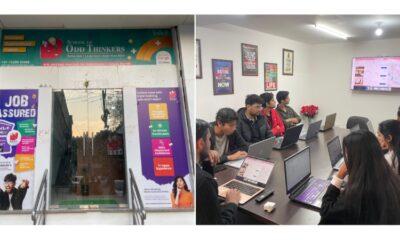Business
How to Make Marketing Metrics More Understandable for the C-suite

The C-suite executives with the shortest tenures are CMOs. This is mostly due to the challenge CMOs face in demonstrating the economic benefit of marketing expenditures. Even with improvements in addressability and attribution, marketers are still having trouble coming up with ROI metrics that satisfy the CEO and CFO.
The ROI metrics challenge
The most significant challenge in creating valuable ROI estimations is choosing the appropriate marketing metrics. Marketers are fighting for consumers’ attention by marketing channels with offers and content.
The planned goals frequently become unclear in this hectic setting. While metrics for “top of the funnel” (TOFU) and “bottom of the funnel” (BOFU) activities, including click-through rates and sales conversions, are reasonably simple to define, middle-of-the-funnel (MOFU) activities sometimes have vague and generic metrics.
Establishing clear results
At every point of the funnel, marketing must explicitly state the expected results. This entails establishing SMART (specific, measurable, achievable, relevant, and time-bound) objectives for each campaign and activity.
It is most difficult to create KPIs for MOFU activities. This is so that MOFU can increase interaction and cultivate relationships through extremely creative, custom content. The majority of analytics solutions available today, whether they use AI or not, frequently fall back on standard metrics like views or downloads.
MOFU metrics ought to capture the depth of engagement as well as surface-level interactions. Time on page and downloads are examples of significant metrics. More sophisticated measures include:
- Page flow: To find drop-off locations, examine the route visitors travel on your website. Higher engagement can result from better user experience and content refinement, which are enhanced by knowing where prospective buyers are leaving the website.
- Monitoring events: keeps track of particular activities like watching videos, attending webinars, or interacting on social media. These events serve as markers of user involvement and interest, offering information on the most successful content kinds.
- Measuring certain calls to action (CTAs) like phone calls, inquiries, or other non-sale conversions is known as bespoke metrics. Accurate measurement of each campaign’s distinct objectives is ensured by customizing metrics to certain marketing initiatives.
The lead scores, which are the most significant MOFU metric of all, depend heavily on these metrics. An ideal lead score would rate a prospect’s willingness to buy and give the prospect pipeline an estimated monetary value (EV) determined by the interest products, degree of involvement, and the likelihood of a purchase. For the majority of marketing tasks, giving your prospects an EV can be revolutionary because it gives you ownership of the revenue.
Integrating advanced analytics and AI
Though they must be used carefully, AI and advanced analytics have the potential to offer deeper insights into marketing success. AI can be used to spot trends and forecast results based on past data, but these insights need to be in line with specific, calculated objectives.
Machine learning algorithms, for example, are capable of analyzing enormous volumes of data to identify leads that have the highest conversion rates. To guarantee accuracy and applicability, the metrics that feed these models must be carefully selected.
Tracking and reporting on important metrics is made simpler by streamlining the measuring process through the integration of AI solutions with current marketing systems. But to close the knowledge gap between technical data analysis and strategic decision-making, CMOs must make sure that their teams are prepared to understand and act upon AI-generated insights.
Additionally, by offering more detailed insights into customer behavior, AI improves MOFU measures. AI, for instance, can provide a comprehensive picture of engagement by analyzing user interactions across numerous touchpoints. This makes it possible for marketers to precisely identify high-value leads and modify their tactics to successfully nurture these prospects. However, the accuracy of the metrics being utilized and the quality of the data are what will determine AI’s performance in this situation.
Improving CFO-CMO Collaboration
Marketing should concentrate on explaining the financial impact of marketing initiatives in language that the finance team can understand to improve cooperation with finance. This comprises:
- Transparent reporting: delivering reports that are easy to read and emphasize important indicators along with the financial ramifications of each. Complex data can be presented understandably especially well with the help of visual dashboards.
- Regular updates: With the CFO, schedule frequent check-ins to assess marketing success and make any necessary strategy adjustments. This guarantees that the financial team can give fast input and is always up to date on the most recent developments.
- Shared goals: matching more general corporate objectives with marketing targets. It is simpler to show how important marketing initiatives are to the overall success of the company when the finance and marketing departments collaborate toward shared goals.
Furthermore, CMOs ought to make an effort to comprehend the viewpoint of the CFO and the financial indicators that are most important to them. This entails converting marketing metrics into monetary measures, such as customer lifetime value (CLV) and gross profit per acquisition (GPPA), which are used to calculate return on marketing investment (ROMI). Marketing can gain credibility and confidence by speaking the CFO’s language, which will make it simpler to defend marketing expenditure.
The role of technology in clarifying metrics
CMOs can better understand KPIs and show the financial effect of marketing initiatives with the use of technology. Customer relationship management (CRM) software, marketing automation platforms, and advanced analytics tools can all offer the information and understanding required to monitor performance precisely. But technology on its own is insufficient. CMOs have to make sure that the people in their teams know how to use these tools and understand the data they provide.
Marketing teams can become adept at data analysis and AI applications by investing in training and development. This improves their capacity for performance evaluation and allows them to make data-driven decisions that spur company expansion.
Future trends in marketing metrics
New trends in marketing are assisting CMOs in developing precise financial indicators. Among them are:
- Predictive analytics is the use of past data to forecast future events. Marketers may forecast the short- and long-term profitability of their customers with the aid of predictive analytics.
- Analyzing the complete customer journey to see how various touchpoints affect conversions is known as customer journey analytics. This all-encompassing method helps marketers optimize their tactics and offers greater insights into consumer behavior.
- Ascertaining how various marketing initiatives contribute to conversions is known as “attribution modeling.” CMOs may better explain their investment by using advanced attribution models, which can give a more accurate picture of marketing effectiveness.
Transforming marketing’s financial narrative
The need to prove the financial benefit of marketing initiatives is driving a change in the CMO’s job description. CMOs may transform the difficulty of winning over CFOs into a chance to demonstrate the real significance of marketing in fostering company performance by taking a strategic approach to analytics and maintaining a dedication to openness.
CMOs may overcome the difficulty of defending their marketing expenditures by providing clear KPIs, assigning a value to the active funnel, and encouraging improved cooperation with finance. They establish themselves in the C-suite and promote long-term corporate growth by doing this.
-

 Business4 weeks ago
Business4 weeks agoHow to fill MSME Form 1? Step-by-Step Guide
-
Business4 weeks ago
From Marine to Chief: The Leadership Journey of Sean Mannix
-

 Gadget4 weeks ago
Gadget4 weeks agoAfter Grand Success on BLDC Ceiling Fan, Eff4 Is Launching Smart Bulb
-

 Festivals & Events4 weeks ago
Festivals & Events4 weeks agoGoogle Celebrates Cherry Blossom Season with Animated Doodle
-

 Business2 weeks ago
Business2 weeks agoPrakash and Kamal Hinduja: Driving Social and Environmental Change
-
Education3 weeks ago
Fred DuVal: University Leadership as a Critical Resource for Climate Change Research and Life-Saving Solutions
-

 Sports4 weeks ago
Sports4 weeks ago2025 NASCAR Craftsman Truck Series Baptist Health 200 at Homestead-Miami Speedway: Race Preview, Prediction, Schedule, Entry List, Drivers to Watch and How to Watch
-

 Health2 weeks ago
Health2 weeks agoThe Hinduja Brothers Commitment to Global Health: Empowering Communities Across Borders

























